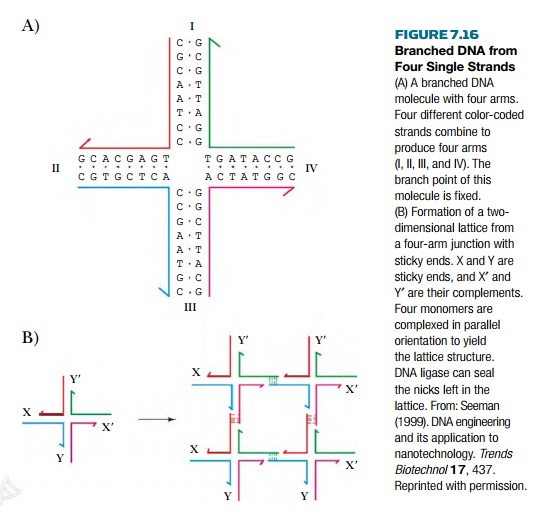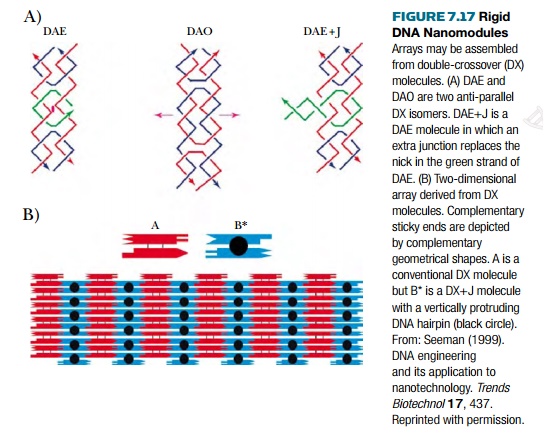Chapter: Biotechnology Applying the Genetic Revolution: Nanobiotechnology
Nanoengineering of DNA
NANOENGINEERING OF DNA
In “classical” genetic engineering, the sequence of DNA is deliberately altered in order to generate new combinations of genetic information. Even when major rearrangements are made, in order to function as genetic information, the DNA must remain as a base-paired double-stranded helix with an overall linear structure.

In nanoengineering, the
objective is to make structures using DNA merely as a structural element,
rather than to manipulate genetic information. DNA is attractive because the
double helix is a convenient structural module. Moreover, its natural
base-pairing properties can be used to link separate DNA molecules together.
However, a critical requirement for assembling 3D structures is branched DNA.
Although branched structures do form in biological situations (especially the
Holliday junction involved in crossing over during recombination), they are not
permanent or stable.
Cross-shaped DNA can be
generated by mixing four carefully designed single strands with different
sequences. Each strand base-pairs with
two of the other strands over half its length (Fig. 7.16). If sticky ends are
included in the initial strands, it is possible to link the crosses together
into a two-dimensional matrix. The nicks
can be sealed by DNA ligase if desired. The principles used in branching can be
extended to three dimensions, and it is possible to build cubical DNA lattices.
The DNA double helix is about
2 nm wide with a helical pitch of about 3.5 nm. Hence it can be used to build
nanoscale frameworks. These can be used for the assembly of other components,
such as metallic nanowires or nanocircuits. Note that while DNA is flexible
over longer distances, it is relatively rigid over nanoscale lengths, up to
about 50 nm.

Such cross-shaped DNA
molecules (and the 3D counterparts) have the drawback that the junctions are
flexible and do not maintain rigid 90-degree angles. Rigid DNA components have
been made by using double crossover (DX) DNA molecules. Two isomers of
antiparallel DX DNA exist, with an odd (DAO) or even (DAE) number of half-turns
between the crossover points (Fig. 7.17). (Double crossover molecules with
parallel strands also exist, but behave poorly from a structural viewpoint.)
DAE or DAO units can be assembled into a rigid array by providing appropriate
sticky ends. It is possible to replace the central, short DNA strand of the DAE
structure with a longer protruding strand of DNA (DAE+J). This allows assembly
of branched structures.
What is the purpose of
building arrays and 3D structures from DNA? Perhaps the most plausible use
suggested so far is to use the DNA as the framework for assembling nanoscale
electronic circuits. So far, normal, unbranched DNA has been used as a scaffold
to create linear metallic nanowires. Various metals (gold, silver, copper,
palladium, platinum) have been used to coat the DNA, and diameters range from
100 nm down to 3 nm. Eventually, it should be possible to put together these
two approaches and build circuits from metal-covered 3D DNA structures.
Related Topics